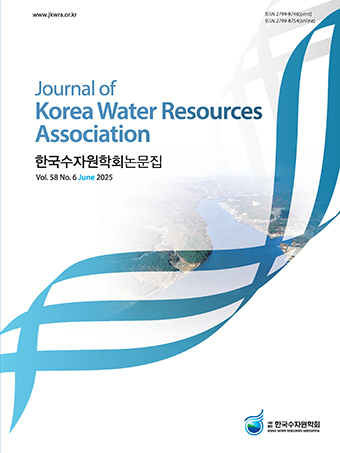Abstract
References
Ahiablame, L., and Shakya, R. (2016). “Modeling flood reduction effects of low impact development at a watershed scale.” Journal of Environmental Management, Vol. 171, No. 15, pp. 81-91. Ahiablame, L., Engel, B., and Chaubey, I. (2012). “Effectiveness of low impact development practices: literature review and suggestions for future research.” Water, Air, and Soil Pollution, Vol. 223, No. 7, pp. 4253-4273. Baek, S.-S., Choi, D.-H., Jung, J.-W., Lee, H.-J., Lee, H., Yoon, K.-S., and Cho, K.H. (2015). “Optimizing low impact development (LID) for stormwater runoff treatment in urban area, Korea: experimental and modeling approach.” Water Research, Vol. 86, pp. 122-131. Bloorchian, A. A., Ahiablame, L., Osouli, A., and Zhou, J. (2016). “Modeling BMP and vegetative cover performance for highway stormwater runoff reduction.” Procedia Engineering, Vol. 145, pp. 274-280. Chung, E.-S., and Kim, Y. (2014). “Development of fuzzy multi- criteria approach to prioritize locations of treated wastewater use considering climate change scenarios.” Journal of Environ-mental Management, Vol. 146, pp. 505-516. Collins, K. A., Hunt, W. F., and Hathaway, J. M. (2008). “Hydrologic comparison of four types of permeable pavement and Standard Asphalt in Eastern North Carolina.” Journal of Hydrologic Engineering, Vol. 13, pp. 1146-1157. Damodaram, C., Giacomoni, M. H., Prakash Khedun, C., Holmes, H., Ryan, A., Saour, W., and Zechman, E.M. (2010). “Simulation of combined best management practices and low impact development for sustainable stormwater management.” Journal of the American Water Resources Association, Vol. 46, No. 5, pp. 907-918. Fassman, E. A., and Blackbourn, S. (2010). “Urban runoff mitigation by a permeable pavement system over impermeable soils.” Journal of Hydrologic Engineering, Vol. 15, pp. 475-485. Finney, K., and Gharabaghi, B. (2011). “Using the PCSWMM 2010 SRTC tool to design a compost biofilter for highway stormwater runoff treatment.” Journal of Water Management Modeling, R241-R209. Gao, J., Wang, R., Huang, J., and Liu, M. (2015). “Application of BMP to urban runoff control using SUSTAIN model: Case study in an industrial area.” Ecological Modelling, Vol. 318, pp. 177-183. Gardner, R. H., Huff, D. D., O’Neill, R. V., Mankin, J. B., Carney, J., and Jones, J. (1980) “Application of error analysis to marsh hydrology model.” Water Resources Research, Vol. 16, pp. 659-664. Irvine, K., Sovann, C., Suthipong, S., Kok, S., and Chea, E. (2015). “Application of PCSWMM to assess wastewater treatment and urban flooding scenarios in Phnom Penh, Cambodia: A tool to support eco-city planning.” Journal of Water Management Modeling, C389. Kaini, P., Artita, K., and Nicklow, J. W. (2012). “Optimizing structural best management practices using SWAT and genetic algorithm to improve water quality goals.” Water Resources Research, Vol. 26, pp. 1827-1845. Kang, T., Koo, Y., and Lee, S. (2015). “Design of stormwater pipe considering vegetative swale with water conveyance.” Journal of Korean Society of Hazard Mitigation Vol. 15, pp. 335-343. Ki, S.J., and Ray, C. (2014). “Using fuzzy logic analysis for siting decisions of infiltration trenches for highway runoff control.” Science of the Total Environment, Vol. 493, pp. 44-53. Kim, Y., Chung, E., Jun, S., and Kim, S. U. (2013). “Prioritizing the best sites for treated wastewater instream use in an urban watershed using fuzzy TOPSIS.” Resources, Conservation and Recycling, Vol. 73, pp. 23-32. Lee, J. G., Selvakumar, A., Alvi, K., Riverson, J., Zhen, J. X., Shoemaker, L., and Lai, F.-H. (2012). “A watershed-scale design optimization model for stormwater best management practices.” Environmental Modelling and Software, Vol. 37, pp. 6-18. Martinez-Martinez, E., Nejadhashemi, A. P., Woznicki, S. A., Adhikari, U., and Giri, S., (2015). “Assessing the significance of wetland restoration scenarios on sediment mitigation plan.” Ecological Engineering, Vol. 77, pp. 103-113. Mouritz, M., (1992). Sustainable urban water systems; policy & pofessional praxis. Perth, Australia: Murdoch University. Noh, S., Chung, E., and Seo, Y. (2015). “Performance of a rain barrel sharing network under climate change.” Water, Vol. 7, pp. 3466-3485. Park, I., Kim, H., Chae, S.-K., and Ha, S. (2010). “Probability mass first flush evaluation for combined sewer discharges.” Journal of Environmental Sciences, Vol. 22. No. 6, pp. 915-922. Prince George’s County Department of Environmental Resources (1993). Design manual for use of bioretention in stormwater management, Prince George’s County, Maryland. Maryland, USA: Division of Environmental Management, Watershed Protection Branch. Robinson, B. (2015). “Modeling sanitary sewer groundwater inflow rehabilitation effectiveness in SWMM5 using a two aquifer approach.” Journal of Water Management Modeling, C385. Rossman, L.A. (2015). Storm water management model user’s Manual Version 5.1. United States Environmental Protection Agency, Water Supply and Water Resources Division, National Risk Management Research Laboratory, Cincinnati, Ohio. Saltelli, A., Ratto, M., Andres, T., Campolongo, F., Cariboni, J., Gatelli, D., Saisana, M., and Tarantola, S. (2008) Global Sensitivity Analysis: The Primer. John Wiley & Sons: West Sussex, UK. Song, J. Y., and Chung, E. S. (2017). “A multi-criteria decision analysis framework for prioritizing sites and types of low impact development practices.” Water, Vol. 9, No. 4, doi: 10.3390/w9040291. Song, J., Chung, E. S., and Kim, S. H. (2018). “Decision support systems based on SWMM5.1 for urban water planning and management.” Water, Vol. 10, 146; doi:10.3390/w10020146. Walmsley, A. (1995). “Greenways and the making of urban form.” Landscape and Urban Planning, Vol. 33, No. 1, pp. 81-127. Wu, J., Yu, S. L., and Zou, R. (2006). “A water quality-based approach for watershed wide BMP strategies.” Journal of the American Water Resources Association, Vol. 42, pp. 1193-1204. Yang, J., Son, M., Chung, E., and Kim, I. (2015). “Prioritizing feasible locations for permeable pavement using MODFLOW and multi-criteria decision making methods.” Water Resources Management, Vol. 29, pp. 4539-4555.
Information
- Publisher :KOREA WATER RESOURECES ASSOCIATION
- Publisher(Ko) :한국수자원학회
- Journal Title :Journal of Korea Water Resources Association
- Journal Title(Ko) :한국수자원학회 논문집
- Volume : 51
- No :6
- Pages :491-501
- Received Date : 2018-01-22
- Revised Date : 2018-03-06
- Accepted Date : 2018-03-06
- DOI :https://doi.org/10.3741/JKWRA.2018.51.6.491




 Journal of Korea Water Resources Association
Journal of Korea Water Resources Association










